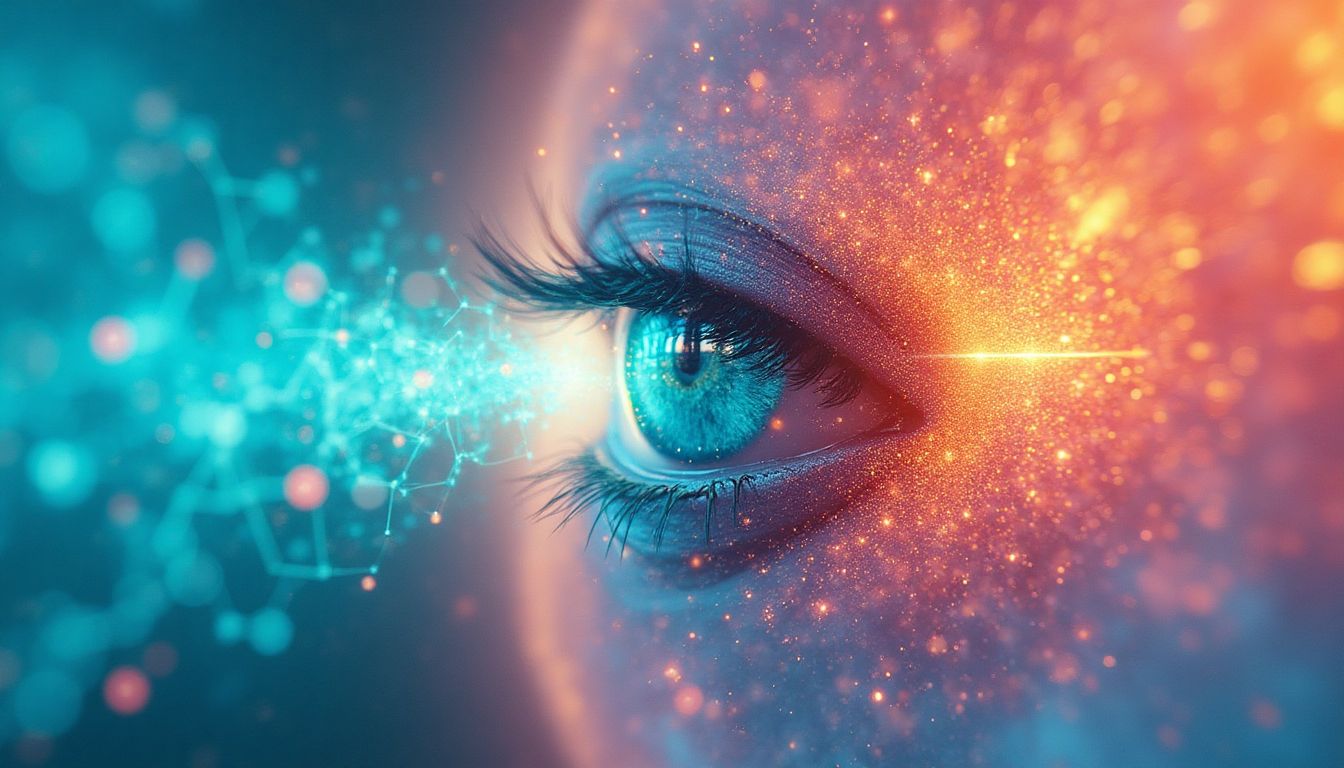Introduction: The Future of Perception
Nothing in life is to be feared, it is only to be understood. Now is the time to understand more, so that we may fear less. – Marie Curie. In the context of synthetic senses, Curie’s wisdom rings true. As we edge closer to a future enriched by technology, the fear of the unknown looms large. But, perhaps understanding AI-driven synthetic senses might quench this fear and spark awe instead. Today, as AI strides confidently into realms once limited to imagination, we unravel the promise of perceiving the unseen and unheard.
Suddenly, the rules of perception are penning new chapters. Have we ever wondered about a reality where our senses are only the starting line? As Ray Kurzweil might argue, the merger of man and machine is closer than ever. Meanwhile, Neil Harbisson, the world's first cyborg artist, paints with colors he hears, and Shannon Vallor, a philosopher of technology, nudges us to question the ethics of these advancements. Together, let's embark on a journey that redefines perception itself.
AI-driven synthetic senses are technologies and systems crafted through artificial intelligence to simulate or enhance human sensory capabilities, enabling perspectives beyond the conventional five senses. This revolutionary approach reimagines our interaction with the world, extending perception into multi-dimensional experiences.
The Concept of Synthetic Senses
What if our five senses are like the first five chapters of a book yet to be finished? The concept of synthetic senses is the sequel, promising more than a mere continuation. Picture synthetic senses as technological upgrades for your sensory toolkit. They don’t just dazzle; they engage in a dance with our natural abilities.
The Evolution of Perception
Our desire to enhance how we experience the world isn't new. From mythical creatures like the all-seeing Argos to neural implants, the story of perception stretches through time. Like Leonardo da Vinci's sketches of flying machines, the evolution of perception inspires a future where our senses can stretch and swivel in unprecedented ways. It's not just about seeing further; it's about seeing beyond.
The Role of AI in Synthetic Senses
Enter artificial intelligence, the magician behind the curtain, transforming raw sensory data like a chef whipping up a gourmet dish. Through algorithms, AI takes sensory inputs and distills them into enhanced experiences. Think of algorithms as the sous-chefs in a bustling kitchen, diligently prepping and perfecting the entree. They don’t just decipher; they interpret. So, if AI had a mantra, it would likely be borrowed from the profound words of Ada Lovelace, seeing "beyond the immediate purpose." This isn't just advancement; it's evolution, with AI as the keystone.
Applications of AI-Driven Synthetic Senses
Picture your everyday life transformed by the power of AI-driven synthetic senses. It might sound like science fiction, but this technology has the potential to revolutionize how we interact with the world. From detecting sneaky diseases that try to hide from our current medical tests, to sniffing out the environment's smallest secrets—AI is set to become the superhero we didn't know we needed.
Healthcare Revolution
In healthcare, AI-enhanced imaging techniques offer a crystal-clear view into the human body, making diseases easier to catch than Pokémon at a convention! These advancements are like equipping doctors with X-ray vision (minus the capes), allowing them to diagnose illnesses at stages so early, you'd think they arrived via express mail. With precise imaging, patients can start treatment with a head start, improving their outcomes.
Environmental Monitoring
When it comes to saving the planet (no capes required here either), AI steps up to the plate as a trusty sidekick. Through smart environmental sensors, AI can monitor air quality, sniff out pollutants, and detect changes in biodiversity like a high-tech nature whisperer. Whether it's catching a whiff of rising carbon dioxide or spotting an endangered species just passing through, AI-driven senses can stay one step ahead and offer timely alerts that help preserve our ecosystems.
Ethical Considerations and Challenges
Caution is key when opening Pandora's box—or in this case, the world of synthetic senses. Our new sensory superpowers come with responsibilities that can't be ignored. Beyond the dazzling potential lies a web of ethical concerns that might leave you scratching your head like a perplexed armadillo in a rainstorm.
Privacy Concerns
Ever feel like Big Brother is watching? With AI-driven senses you might wanna double-check. While delightful in theory, these senses also come with privacy nails-on-a-chalkboard kind of concerns. Imagine being monitored everywhere, from coffee shops to your own living room. Ensuring data privacy will be crucial, lest we end up living out an episode of Black Mirror instead of the next technological utopia.
Accessibility and Equity
Who gets to use these futuristic powers? Making synthetic senses accessible for all is vital. Picture the cool kid at a party showing off their new AI-powered hearing...now what if some couldn't afford to join the fun? Keeping this technology open and accessible may be a challenge, but not addressing it might land us in a world where "have-nots" are left without the magical party invite. Closing this gap is essential to prevent widening tech inequality and ensuring everyone's included in the AI-drastic future we envision.
The Science Behind Synthetic Senses
Imagine unlocking a world where the unseen becomes seen. That's the promise behind AI-driven synthetic senses. At its core are two powerful tools: machine learning and sensor technology advancements — each pushing the boundaries of human perception.
Machine Learning and Neural Networks
Machine learning, like a diligent student, is programmed to decipher complex data that might baffle human eyes. By training neural networks, we teach machines to learn from sensory inputs and unwoven patterns hidden in our data. This capability holds promise for detecting elements that evade the human eye. Consider scenarios where AI systems interpret seismic vibrations or faint sound frequencies before they manifest as detectable events, like an impending earthquake. Machine learning dives deep into chaos and finds order.
Moreover, deploying these AI models means turning raw information into actionable insights. A prime example lies in earthquake prediction. SciTech Daily details how AI can analyze patterns in seismic data to forecast quakes. The magic lies in their ability to process vast data sets quickly, something human brains find challenging.
Sensor Technology Advances
Without the right sensors, AI's computational might becomes useless. Hence, sensors play a vital role in translating the physical world into digital language that AI can interpret. From bio-sensors identifying disease markers to environmental sensors tracking real-time air quality, advancements in these technologies are astounding.
- Bio-sensors: Detect subtle biological changes, crucial for early disease diagnostics.
- Environmental sensors: Monitor pollutants, aiding in ecological balance and public health.
The Centers for Disease Control and Prevention (CDC) underscores the importance of sensors in environmental monitoring. These sensors serve as digital noses, efficiently sniffing out pollutants unnoticed by humans.
Future Directions and Innovations
As we peer into the future, the tapestry of AI-driven synthetic senses is woven with threads of limitless potential. Augmented reality (AR) plays a pivotal role, offering a new lens through which existing senses can be amplified and new senses can be conceived.
Integration with Augmented Reality
Picture donning a pair of AR glasses that not only merges digital with the real but also magically enhances your vision by overlaying vital data. This futuristic technology not only adds a layer but deeply embeds AI-driven synthetic senses into everyday life. For instance, AR aids in real-time translation of languages and helps visually impaired individuals navigate their environments independently.
Brands like Magic Leap are reshaping these narratives, working on headsets that merge virtual layers with sensory enhancements. These innovations highlight AR's transformative potential, not just as a tool for gamers but as an enabler of new sensory dimensions.
Potential for Cross-Sensory Experiences
Envision a world where the boundaries between senses blur. Can you see music or taste colors? While these scenarios might currently reside in the realm of imagination, AI offers genuine paths to explore such experiences, hysterical yet earnestly possible. By transcending traditional boundaries, AI can create environments where multiple senses get involved simultaneously, leading to immersive interactions.
- Art Installations: Imagining a gallery where paintings sing and sculptures produce their own aroma.
- Education: Students grasp complex topics by engaging multiple senses — hearing lessons, visualizing concepts, and even interacting with tactile simulations.
- Communication: Re-imagine video calls, where virtual handshakes resonate with warmth, tone, and context.
Scientific American delves into the possibilities of cross-sensory engagement for clearer insights. We see potential spanning art, education, and even social communication technologies.
AI Solutions: How Would AI Tackle This Issue?
If tasked with advancing human perception through AI-driven synthetic senses, a methodical approach would involve a structured plan that leverages various interdisciplinary fields and scholarly insights. The following outlines potential steps and strategies that institutions, organizations, or governments can enact to foster this technological evolution:
- Establish Collaborative Research Partnerships: Form alliances between technology companies, academic institutions, and healthcare organizations. For example, the Massachusetts Institute of Technology (MIT) could partner with firms like IBM Watson to enhance sensor technologies.
- Leverage Crowdsourcing: Utilize platforms like Kickstarter or Indiegogo to gather innovative ideas from diverse thinkers that target specific sensory enhancements.
- Develop Adaptive Algorithms: Create algorithms that learn from users' unique sensory thresholds, allowing for personalized enhancements. Research suggests that machine learning models, such as those developed by Google Brain, can exponentially improve personalization capabilities.
- Focus on Accessibility: Work to ensure that synthetic senses technologies are made available to underrepresented populations, avoiding a ‘technological divide’ while enhancing equity in access.
Actions Schedule/Roadmap (Day 1 to Year 2)
Day 1: Preliminary Research
Institutions should start with a comprehensive literature review of existing synthetic senses technologies. Identify gaps and possible advancements in current methodologies.
Day 2: Team Formation
Assemble a multidisciplinary team comprising experts in neuroscience, AI, engineering, and sensory technology. This could involve recruiting professionals from renowned institutions such as Stanford University or Harvard University.
Day 3: Stakeholder Engagement
Engage potential stakeholders, including top-ranking tech companies and health organizations, for support and guidance. Community forums can help in gathering public input and fostering a transparent process.
Week 1: Brainstorming Sessions
Conduct focused brainstorming sessions to explore creative concepts for synthetic senses. Employ techniques from organizations like IDEO to enhance innovative thinking.
Week 2: Prototype Ideation
Begin drafting prototypes for initial sensory enhancement technologies, utilizing tools from platforms like Autodesk Fusion 360 for design and simulation.
Week 3: Budgeting and Resource Allocation
Establish a budget and allocate resources among team members, considering collaboration grants available through institutions like NSF for advanced scientific research.
Month 1: Feasibility Studies
Perform feasibility studies to evaluate proposed synthetic senses technologies against required technical specifications. This should involve experts from the National Institute of Standards and Technology for data analysis.
Month 2: Pilot Programs
Launch pilot programs with selected users to gather initial feedback on prototype efficacy, ensuring diverse representation in user testing.
Month 3: Iteration of Designs
Analyze user data from pilot programs and iterate design improvements based on feedback and performance metrics.
Year 1: Continuous Improvement
Focus on refining the technologies, spiral iterating improvements into design protocols based on continually gathered user feedback.
Year 1.5: Academic Partnerships
Formalize partnerships with academic institutions to pursue further research, secure funding, and ensure that the technologies remain cutting-edge.
Year 2: Public Launch
Plan and execute a public launch of AI-driven synthetic senses technology, with an emphasis on accessibility and ethical considerations, utilizing media outlets such as TechCrunch for promoting awareness.
Conclusion: Embracing a New Reality
AI-driven synthetic senses are not just a futuristic fancy; they are the next evolution in how we experience and interact with our world. As this technology matures, we stand at a crossroads where our sense of reality can be dramatically altered. Imagine a society where the blind can see through augmented technologies or the deaf can experience music as a tactile sensation. This is not merely about enhancement but expanding our understanding of existence. While we march toward this multi-dimensional future, we must embrace the ethical dilemmas and the transformative potential that accompanies these advancements—this journey is one we must undertake together. The call for collaboration, inclusivity, and responsible innovation is not just a challenge but a profound opportunity to redefine what it means to perceive the world. Are we ready to unlock these hidden dimensions, or will we remain confined to our current perceptions?
FAQ
What are synthetic senses?
Synthetic senses are advanced technologies that help people see, hear, taste, smell, or feel things that are normally beyond our natural abilities. For example, they can help us detect tiny amounts of a chemical in the air or see colors that our eyes usually can't perceive. These technologies blend science and engineering to expand how we interact with the world.
How does AI contribute to synthetic senses?
Artificial Intelligence (AI) plays a big role in creating synthetic senses. It uses complex algorithms to analyze data and improve our perception. For instance, AI can interpret signals from sensors to give us a clearer understanding of our environment. It helps these systems learn from what they detect, making them smarter over time. You can learn more about AI from sources like IBM’s explanation of AI.
What ethical concerns arise from AI-driven synthetic senses?
With new technology comes new responsibilities. AI-driven synthetic senses can raise some important ethical issues. Here are a few key concerns:
- Privacy: These technologies can monitor our surroundings, which might lead to unwanted surveillance.
- Access: Not everyone may have equal access to these technologies, creating a divide between different social groups.
- Data Ownership: Questions about who owns the data collected by synthetic senses can lead to legal and ethical dilemmas.
Can synthetic senses improve healthcare?
Absolutely! Synthetic senses can revolutionize healthcare by improving diagnostics and monitoring patient conditions. For instance, AI-enhanced imaging technologies can find diseases much earlier than traditional methods. Hospitals are already using tools such as GE Healthcare to provide better care through advanced imaging systems.
What is the future of AI-driven synthetic senses?
The future looks exciting for AI-driven synthetic senses! We can expect developments like:
- Cross-Sensory Experiences: Imagine being able to "taste" music or "see" smells! This could create entirely new ways to experience and share art and communication.
- Integration with Augmented Reality: By combining synthetic senses with augmented reality, we can interact with our environment in ways we've only dreamed of. For instance, a Microsoft HoloLens could be enhanced to help people experience sound from a different location visually.
How are synthetic senses developed?
Developing synthetic senses involves a lot of teamwork across different fields. Here's a simple roadmap of the process:
- Conduct research to identify gaps in existing sensory technologies.
- Assemble a team that includes experts in neuroscience, AI, and technology.
- Engage stakeholders like Harvard University or tech companies for collaboration.
- Brainstorm innovative ideas and design prototypes.
- Test and improve prototypes based on user feedback.
- Launch the technology while considering accessibility and ethical guidelines.
What types of synthetic senses are currently available?
There are many exciting synthetic senses being developed today, including:
- Enhanced Vision: Night vision goggles that allow users to see in the dark.
- Hearing Aids: Devices that amplify sounds, helping the hearing-impaired find clarity in noisy environments.
- Scanners: Devices that can analyze air quality or detect harmful substances.
How can someone learn more about synthetic senses?
If you're curious about synthetic senses, many universities and organizations are studying these technologies. You can check out resources from institutions like Stanford University or organizations like AAAS (American Association for the Advancement of Science), which regularly publish scientific findings related to advancements in sensory technology.
Are there any risks associated with synthetic senses?
Yes, while synthetic senses have many benefits, there are risks to consider, such as:
- Data Security: Data collected by these systems could be hacked or misused.
- Dependence on Technology: Relying too heavily on synthetic senses may reduce our natural abilities over time.
- Bias in Algorithms: If the AI behind the synthetic senses has biases, it could affect the reliability of the information we receive.
Wait! There's more...check out our gripping short story that continues the journey: The Harbinger of Change
Disclaimer: This article may contain affiliate links. If you click on these links and make a purchase, we may receive a commission at no additional cost to you. Our recommendations and reviews are always independent and objective, aiming to provide you with the best information and resources.
Get Exclusive Stories, Photos, Art & Offers - Subscribe Today!





























Post Comment
You must be logged in to post a comment.